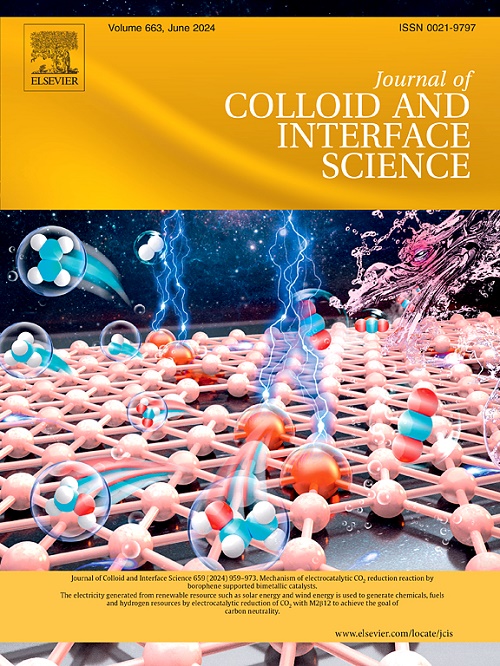Anion vacancy engineered Cu/ZnIn2S4-VS/TiO2-VO S-scheme heterojunction for enhancing photocatalytic overall water splitting
IF 9.4
1区 化学
Q1 CHEMISTRY, PHYSICAL
引用次数: 0
Abstract
Heterojunction materials for photocatalytic overall water splitting (POWS) become popular in recent times. However, even in the superior S-scheme heterojunction, the two semiconductor materials still do not have an efficient activity to separate and migrate photogenerated carriers. To further improve the charge separation and enhance the activity of POWS, a novel S-scheme heterojunction photocatalyst, Cu/ZnIn2S4-VS/TiO2-VO, was synthesized using solvothermal and calcination methods. The photocatalyst consists of Cu/ZnIn2S4 with sulfur vacancies (Cu/ZIS-VS) and TiO2 with oxygen vacancies (TiO2-VO). The resultant photocatalyst exhibited optimal hydrogen and oxygen evolution rates of 1245.3 μmol/g/h and 621.4 μmol/g/h, respectively. The apparent quantum efficiency reached 5.8 % at 365 nm. The corresponding characterization and theoretical calculations demonstrated the S-scheme heterojunction between Cu/ZIS-VS and TiO2-VO was successfully synthesized and resulted in a notable enhancement in the effective separation of carriers. Sulfur and oxygen vacancies in ZIS and TiO2, respectively, led to a reduction in their band gaps, which is beneficial for electron migration. Moreover, copper doping augmented the light absorption capabilities. Sulfur vacancies caused charge delocalization which facilitated the transfer of electrons and consequently enhanced the photocatalytic activity. This research provided an innovative perspective on the exploration and development of S-scheme heterojunctions aimed at POWS.

阴离子空位工程Cu/ZnIn2S4-VS/TiO2-VO S-scheme异质结增强光催化整体水分解。
异质结材料用于光催化全面水分解(POWS)是近年来研究的热点。然而,即使在优越的S-scheme异质结中,这两种半导体材料仍然没有有效的分离和迁移光生载流子的活性。为了进一步改善POWS的电荷分离性能,提高POWS的活性,采用溶剂热法和煅烧法合成了一种新型的s型异质结光催化剂Cu/ZnIn2S4-VS/TiO2-VO。光催化剂由含硫空位的Cu/ZnIn2S4 (Cu/ZIS-VS)和含氧空位的TiO2 (TiO2- vo)组成。所得光催化剂的最佳析氢速率为1245.3 μmol/g/h,析氧速率为621.4 μmol/g/h。在365 nm处,表观量子效率达到5.8%。相应的表征和理论计算表明,Cu/ZIS-VS和TiO2-VO之间的s型异质结成功合成,并显著增强了载流子的有效分离。ZIS和TiO2中分别存在硫空位和氧空位,导致其带隙减小,有利于电子迁移。此外,铜掺杂增强了光吸收能力。硫空位引起电荷离域,促进了电子的转移,从而提高了光催化活性。本研究为战俘s型异质结的探索和开发提供了一个创新的视角。
本文章由计算机程序翻译,如有差异,请以英文原文为准。
求助全文
约1分钟内获得全文
求助全文
来源期刊
CiteScore
16.10
自引率
7.10%
发文量
2568
审稿时长
2 months
期刊介绍:
The Journal of Colloid and Interface Science publishes original research findings on the fundamental principles of colloid and interface science, as well as innovative applications in various fields. The criteria for publication include impact, quality, novelty, and originality.
Emphasis:
The journal emphasizes fundamental scientific innovation within the following categories:
A.Colloidal Materials and Nanomaterials
B.Soft Colloidal and Self-Assembly Systems
C.Adsorption, Catalysis, and Electrochemistry
D.Interfacial Processes, Capillarity, and Wetting
E.Biomaterials and Nanomedicine
F.Energy Conversion and Storage, and Environmental Technologies

 求助内容:
求助内容: 应助结果提醒方式:
应助结果提醒方式:


